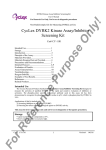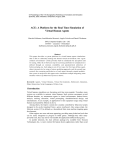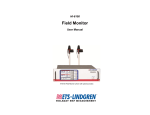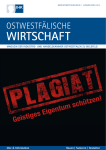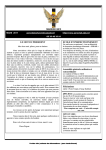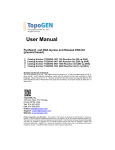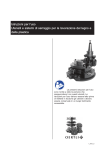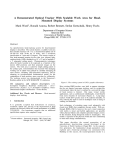Download CY-1170
Transcript
Non-Radioisotopic Kit for Measuring CK2 activity On ly! CK2 KinaseAssay/Inhibitor Screening Kit User’s Manual For Research Use Only, Not for use in diagnostic procedures CycLex CK2 Kinase Assay/Inhibitor Screening Kit Pu rp Intended Use................................................ 1 Storage......................................................... 1 Introduction.................................................. 2 Principle of the Assay.................................. 3 Materials Provided....................................... 4 Materials Required but not Provided........... 4 Precautions and Recommendations............. 5 Detailed Protocol......................................... 6-9 Evaluation of Results................................... 9 Assay Characteristics................................... 9 Troubleshooting...........................................10 Reagent Stability..........................................10 Example of Test Results............................. 11-12 References................................................... 13 Related Products..........................................14 os e Cat# CY-1170 ce Intended Use en The CycLex Research Product CycLex CK2 Kinase Assay/Inhibitor Screening Kit designed to measure the activities of purified CK2 for the rapid and sensitive evaluation of inhibitors or activators. The phospho-serine specific monoclonal antibody used in this assay kit has been demonstrated to recognize the phospho-serine46 residue in p53, which is phosphorylated by CK2 in vitro. Applications of this kit include: 1) Screening inhibitors or activators of CK2. 2) Detecting the effects of pharmacological agents on CK2 activity. Storage er This assay kit is for research use only and not for use in diagnostic or therapeutic procedures. rR ef • Upon receipt store all components at 4°C. • Don’t expose reagents to excessive light. Fo Cat#: CY-1170 1 Version#: 141117 On ly! CK2 KinaseAssay/Inhibitor Screening Kit User’s Manual For Research Use Only, Not for use in diagnostic procedures Introduction Measurement of CK2 activity Pu rp os e Protein kinase Casein kinase II (CK2) is a ubiquitous and pleiotropic seryl/threonyl protein kinase, which appears to interact with different signaling pathways and therefore represents the prototype of a multifunctional protein kinase. The holoenzyme is generally composed of two catalytic (alpha and/or alpha') and two regulatory (beta) subunits (1-3), but the free alpha/alpha' subunits are catalytically active by themselves. Although the beta subunits deeply affect many properties of CK2, both the isolated catalytic subunits and the holoenzyme are constitutively active. The enzyme is highly expressed in most cancers (4) and this higher expression has been tentatively correlated with the involvement of CK2 in the promotion of specific phases of the cell cycle (5). Unlike the majority of protein kinases, which are tightly regulated enzymes, CK2 is endowed with high constitutive activity, a feature that is suspected to underlie its oncogenic potential (6, 7) and possible implication in viral infections. This makes CK2 an attractive target for anti-neoplastic and antiviral drugs Experimental studies suggest that dysregulated expression of the alpha subunit of CK2 imparts an oncogenic potential in the cells such that in cooperation with certain oncogenes (8, 9), it produces a profound enhancement of the tumor phenotype. Recent studies have provided evidence that overexpression of CK2 in tumor cells is not simply a reflection of tumor cell proliferation alone but additionally may reflect the pathobiological characteristics of the tumor. Of considerable interest is the possibility that CK2 dysregulation in tumors may influence the apoptotic activity in those cells (10-12). Approaches to interfering with the CK2 signal may provide a useful means for inducing tumor cell death (13) . rR ef er en ce The protocol generally regarded as most sensitive for the quantitative measurement of CK2 activity involves incubation of the CK2 sample with substrate, either a natural or synthetic polypeptide (such as CK2 substrate peptide; RRRDDDSDDD), in the presence of Mg2+ and 32P-labeled ATP. The reaction is terminated by "spotting" a sample onto a phosphocellulose P81 filter paper disc, followed by washing extensively to remove unincorporated radiolabel and the incorporated radioactivity on P81 filter is counted. While sensitive, this method is labor-intensive, generates hazardous radioactive waste, and depends on a radioisotope of short half-life. It is particularly unsuitable when kinase assays are only performed on an infrequent basis. The CycLex Research Product CycLex CK2 Kinase Assay/Inhibitor Screening Kit uses a peroxidase coupled anti-phospho-p53 serine46 monoclonal antibody as a reporter molecule in a 96-well ELISA format. This assay provides a non-isotopic, sensitive and specific method to detect CK2 activity. Fo Cat#: CY-1170 2 Version#: 141117 On ly! CK2 KinaseAssay/Inhibitor Screening Kit User’s Manual For Research Use Only, Not for use in diagnostic procedures Principle of the Assay Pu rp os e The CycLex Research Product CycLex CK2 Kinase Assay/Inhibitor Screening Kit is a single-site, semi-quantitative immunoassay for CK2 activity. Plates are pre-coated with a substrate corresponding to recombinant p53, which contains a serine residue that are phosphorylated by CK2 (Casein kinase II). The detector antibody specifically detects only the phosphorylated form of serine46 on p53. The CycLex Research Product CycLex CK2 Kinase Assay/Inhibitor Screening Kit can be used to study the kinetics of a purified or partially purified CK2 as well as to screening these kinases inhibitor. To perform the test, the sample is diluted in Kinase Buffer, pipetted into the wells and allowed to phosphorylate the bound substrate in the presence of Mg2+ and ATP. The amount of phosphorylated substrate is measured by binding it with a horseradish peroxidase conjugate of TK-4D4, an anti-phospho-p53 serine46 specific antibody, which then catalyzes the conversion of the chromogenic substrate tetra-methylbenzidine (TMB) from a colorless solution to a blue solution (or yellow after the addition of stopping reagent). The color is quantified by spectrophotometry and reflects the relative amount of CK2 activity in the sample. For kinetic analysis, the sample containing CK2 is added to the wells in a similar fashion and at varying times the reaction is stopped by the addition of a chelator, sodium ethylenediaminetetraacetate (EDTA) and the amount of phosphorylated substrate determined as before. The CycLex Research Product CycLex CK2 Kinase Assay/Inhibitor Screening Kit is designed to accurately determine the presence and relative amount of CK2 activity in purification column fractions, and to determine non-isotopic kinetic analysis of CK2 activity. Careful attention to methods of chromatography and the assay protocol will provide the investigator with a reliable tool for the evaluation of CK2 activity. Summary of Procedure Add 100 µL of reaction mix to the wells Incubate for 30 min at 30°C ce Wash the wells en Add 100 µL of HRP conjugated anti-phosphorylated form specific antibody Incubate for 30 min at room temp. Wash the wells er Add 100 µL of Substrate Reagent ef Add 100 µL of Stop Solution rR Measure absorbance at 450 nm Fo Cat#: CY-1170 3 Version#: 141117 On ly! CK2 KinaseAssay/Inhibitor Screening Kit User’s Manual For Research Use Only, Not for use in diagnostic procedures Materials Provided All samples and standards should be assayed in duplicate. The following components are supplied and are sufficient for the one 96-well microtiter plate kit. Microplate: One microplate supplied ready to use, with 96 wells (12 strips of 8-wells) in a foil, zip-lock bag with a desiccant pack. Wells are coated with recombinant p53 N-terminus (1-99 a.a.) as substrate of CK2. os e 10X Wash Buffer: One bottle containing 100 mL of 10X buffer containing 2 %Tween®-20 Kinase Buffer: One bottle containing 20 mL of 1X buffer; used for Kinase Reaction Buffer and sample dilution. 20X ATP: One vial of lyophilized ATP Na2 salt. Pu rp HRP conjugated Detection Antibody: One vial containing 12 mL of HRP (horseradish peroxidase) conjugated anti-phospho-p53 S46 monoclonal antibody (TK-4D4). Ready to use. Substrate Reagent: One bottle containing 20 mL of the chromogenic substrate, tetra-methylbenzidine (TMB). Ready to use. Stop Solution: One bottle containing 20 mL of 1 N H2SO4. Ready to use. Materials Required but not Provided rR ef er en ce • CK2 (alpha/beta) and CK2 (alpha’/beta) positive control: Available from CycLex (Cat # CY-E1170-1 and Cat # CY-E1170-2), One vial contains 4 units/100 µL CK2 enzyme. Positive control should be added to the first well at 20 m units/well. For instance, diluted positive control 1:20, use 10 µL for 1 assay. (Unused CK2 enzyme should be stored in aliquots at -70°C.) • 10X Heparin (1 µg/mL): Heparin Na is available from Sigma, Cat#. H-4784. 100 µg/mL stock solution (H2O) diluted 1:100 in Kinase Buffer. • Pipettors: 2-20 µL, 20-200 µL and 200-1000 µL precision pipettors with disposable tips. • Precision repeating pipettor • Wash bottle or multichannel dispenser for plate washing. • Microcentrifuge and tubes for sample preparation. • Vortex mixer • Plate reader capable of measuring absorbance in 96-well plates at dual wavelengths of 450 nm/540 nm. Dual wavelengths of 450/550 or 450/595 nm can also be used. The plate can also be read at a single wavelength of 450 nm, which will give a somewhat higher reading. • 500 or 1000 mL graduated cylinder • Reagent reservoirs • Deionized water of the highest quality • Disposable paper towels Fo Cat#: CY-1170 4 Version#: 141117 Precautions and Recommendations • Allow all the components to come to room temperature before use. On ly! CK2 KinaseAssay/Inhibitor Screening Kit User’s Manual For Research Use Only, Not for use in diagnostic procedures • All microplate strips that are not immediately required should be returned to the zip-lock pouch, which must be carefully resealed to avoid moisture absorption. • Do not use kit components beyond the indicated kit expiration date. os e • Use only the microtiter wells provided with the kit. • Rinse all detergent residue from glassware. • Use deionized water of the highest quality. • Do not mix reagents from different kits. Pu rp • The buffers and reagents in this kit may contain preservatives or other chemicals. Care should be taken to avoid direct contact with these reagents. • Do not mouth pipet or ingest any of the reagents. • Do not smoke, eat, or drink when performing the assay or in areas where samples or reagents are handled. • Dispose of tetra-methylbenzidine (TMB) containing solutions in compliance with local regulations. • Avoid contact with Substrate Solution which contains hydrogen peroxide. ce • Avoid contact with Stop Solution which contains Sulfuric Acid. • In case of contact with the Stop Solution and the Substrate Solution, wash skin thoroughly with water and seek medical attention, when necessary. en • Biological samples may be contaminated with infectious agents. Do not ingest, expose to open wounds or breathe aerosols. Wear protective gloves and dispose of biological samples properly. rR ef er • CAUTION: Sulfuric Acid is a strong acid. Wear disposable gloves and eye protection when handling Stop Solution. Fo Cat#: CY-1170 5 Version#: 141117 On ly! CK2 KinaseAssay/Inhibitor Screening Kit User’s Manual For Research Use Only, Not for use in diagnostic procedures Detailed Protocol The CycLex Research Product CycLex CK2 Kinase Assay/Inhibitor Screening Kit is provided with removable strips of wells so the assay can be carried out on separate occasions using only the number of strips required for the particular determination. Since experimental conditions may vary, an aliquot of the CK2 (Cat # CY-E1170-1 or CY-E1170-2), available separately from CycLex, should be included in each assay as a positive control. Disposable pipette tips and reagent troughs should be used for all liquid transfers to avoid cross-contamination of reagents or samples. os e Preparation of Working Solution 1. Prepare a working solution of Wash Buffer by adding 100 mL of the 10X Wash Buffer (provided) to 900 mL of ddH2O. Mix well. Store at 4°C for two weeks or -20°C for long-term storage. 2. Prepare 20X ATP Solution by adding 0.8 mL of ddH2O to the vial of 20X ATP (provided, lyophilized). Mix gently until dissolved. the Final concentration of the 20X ATP Solution should be 2.5 mM. Store the solution in small aliquots (e.g. 100 µL) at -20°C. Kinase Buffer (provided) 20X ATP Solution Total Pu rp 3. Prepare Kinase Reaction Buffer by mixing following reagents. 96 assays 10 assays 1 assay 9.5 mL 0.5 mL 950 µL 50 µL 95 µL 5 µL 10 mL 1000 µL 100 µL ce You will need 80-90 µL of Kinase Reaction Buffer per assay well. Mix well. Discard any unused Kinase Reaction Buffer after use. Standard Assay en 1. Remove the appropriate number of microtiter wells from the foil pouch and place them into the well holder. Return any unused wells to the foil pouch, refold, seal with tape and store at 4°C. 2. Prepare all samples (diluted with Kinase Buffer as needed). All samples should be assayed in duplicate. er 3. To assay partially purified recombinant CK2, add 10 µL of each fraction to the wells of the assay plate on ice. Duplicate wells containing 20 m units/10 µL CK2 (Cat # CY-E1170-1 or Cat # CY-E1170-2) should be included in each assay as a positive control for phosphorylation. ef 4. Begin the kinase reaction by addition of 90 µL Kinase Reaction buffer per well, cover with plate sealer, and incubate at 30°C for 30 minutes. rR 5. Wash wells five times with Wash Buffer making sure each well is filled completely. Remove residual Wash Buffer by gentle tapping or aspiration. 6. Pipette 100 µL of HRP conjugated Detection Antibody into each well, cover with a plate sealer and incubate at room temperature (ca.25°C) for 30 minutes. Discard any unused conjugate. Fo Cat#: CY-1170 6 Version#: 141117 On ly! CK2 KinaseAssay/Inhibitor Screening Kit User’s Manual For Research Use Only, Not for use in diagnostic procedures 7. Wash wells five times as same as in step 5. 8. Add 100 µL of Substrate Reagent to each well and incubate at room temperature (ca.25°C) for 5–15 minutes. 9. Add 100 µL of Stop Solution to each well in the same order as the previously added Substrate Reagent. os e 10. Measure absorbance in each well using a spectrophotometric plate reader at dual wavelengths of 450/540 nm. Dual wavelengths of 450/550 or 450/595 nm can also be used. Read the plate at 450 nm if only a single wavelength can be used. Wells must be read within 30 minutes of adding the Stop Solution. Note-1: Complete removal of liquid at each step is essential to good performance. After the last wash, remove any remaining Wash Buffer by aspirating or decanting. Invert the plate and blot it against clean paper towels. Pu rp Note-2: Reliable signals are obtained when either O.D. values do not exceed 0.25 units for the blank (no enzyme control), or 2.5 units for the CK2 positive control. Note-3: If the microplate reader is not capable of reading absorbance greater than the absorbance of the Wee1 positive control, perform a second reading at 405 nm. A new O.D. values, measured at 405 nm, is used to determine CK2 activity of off-scale samples. The readings at 405 nm should not replace the on-scale readings at 450 nm. Kinetic Assay ce 1. Remove the appropriate number of microtiter wells from the foil pouch and place them into the well holder. Return any unused wells to the foil pouch, refold, seal with tape and store at 4°C. 2. Prepare all samples (diluted with Kinase Buffer as needed). All samples should be assayed in duplicate. en 3. To assay partially purified recombinant CK2, add 10 µL of each fraction to the wells of the assay plate on ice. Duplicate wells containing 20 m units/10 µL CK2 (Cat # CY-E1170-1 or Cat # CY-E1170-2) should be included in each assay as a positive control for phosphorylation. er 4. Begin kinase reaction by addition of 90 µL Kinase Reaction Buffer in duplicate per well in timed intervals (suggested interval is 5 minutes but should be individually determined for each system). After the final addition, incubate at 30°C for 20 minutes. ef 5. Stop the reaction by flicking out the contents. (Alternatively, the reaction may be terminated by the addition of 150 µL 0.1 M Na EDTA, pH 8.0 to each well). 6. Wash wells five times with Wash Buffer making sure each well is filled completely. Remove residual Wash Buffer by gentle tapping or aspiration. rR 7. Pipette 100 µL of HRP conjugated Detection Antibody into each well, cover with a plate sealer and incubate at room temperature (ca.25°C) for 30 minutes. Discard any unused conjugate. Fo Cat#: CY-1170 7 Version#: 141117 On ly! CK2 KinaseAssay/Inhibitor Screening Kit User’s Manual For Research Use Only, Not for use in diagnostic procedures 8. Wash wells five times as same as in step 6. 9. Add 100 µL of Substrate Reagent to each well and incubate at room temperature (ca.25°C) for 10-15 minutes. 10 add 100 µL of Stop Solution to each well in the same order as the previously added Substrate Reagent. os e 11. Measure absorbance in each well using a spectrophotometric plate reader at dual wavelengths of 450/540 nm. Dual wavelengths of 450/550 or 450/595 nm can also be used. Read the plate at 450 nm if only a single wavelength can be used. Wells must be read within 30 minutes of adding the Stop Solution. Recommendations Pu rp Special considerations when screening activators or inhibitors In order to estimate the inhibitory effect on CK2 activity in the test chemicals correctly, it is necessary to conduct the control experiment of “Solvent control” at least once for every experiment and “Inhibitor control” at least once for the first experiment, in addition to “Test sample”, as indicated in the following table. When test chemicals cause an inhibitory effect on CK2 activity, the level of A450 is weakened as compared with “Solvent control”. The high level of A450 is not observed in “Inhibitor control” (usually A450<0.3). Assay reagents Kinase Reaction Buffer 10X Inhibitor or equivalent 10X Heparin (1 µg/mL)* Solvent control 80 µL 80 µL Inhibitor control 80 µL 10 µL - - - 10 µL - - - 10 µL ce Solvent for Inhibitor Test sample CK2 Positive Control (2 m unit/µL)** 10 µL 10 µL or your enzyme fraction * 10X Heparin (1 µg/mL): See page 4, section “Materials Required but not Provided” 10 µL en ** Cat # CY-E1170-1 or Cat # CY-E1170-2: See page 4, section “Materials Required but not Provided” 1. Following the above table, add the Reagents to each well of the microplate. Finally, initiate reaction by adding 10 µL of “Diluted CK2 positive control” to each well and mixing thoroughly at room temperature. Cover with plate sealer. Incubate at 30°C for 30 minutes. rR ef er 2. Follow the Standard Assay, steps 5-10, page 6-7. Fo Cat#: CY-1170 8 Version#: 141117 On ly! CK2 KinaseAssay/Inhibitor Screening Kit User’s Manual For Research Use Only, Not for use in diagnostic procedures Special considerations when measuring precise CK2 activity In order to measure the activity of CK2 correctly, it is necessary to conduct the control experiment of “Inhibitor control” at least once for every experiment and “ATP minus control” at least once for the first experiment, in addition to “No enzyme control” as indicated in the following table. Although the level of A450 increases in “Test sample” when CK2 enzyme activity is in the sample, the high level of A450 is not observed in “Inhibitor control”, “ATP minus control” and “No enzyme control”. 90 µL Kinase Buffer (provided) - - 10X Heparin (1 µg/mL)* - 10 µL 10 µL 10 µL - - - - Test Sample Your enzyme fraction CK2 Positive Control (2 m unit/µL)** Buffer ATP minus control - Positive control 90 µL No enzyme control 90 µL 90 µL - - - - - 10 µL - - - 10 µL - - - 10 µL os e Kinase Reaction Buffer Inhibitor control 80 µL Assay reagents Pu rp * 10X Heparin (1 µg/mL): See page 4, section “Materials Required but not Provided” ** Cat # CY-E1170-1 or Cat # CY-E1170-2: See page 4, section “Materials Required but not Provided” 1. Following the above table, add the Reagents to each well of the microplate. Finally, initiate the reaction by adding 10 µL of “Your enzyme fraction” or “Buffer” to each well and mixing thoroughly at room temperature. Cover with plate sealer. Incubate at 30°C for 30 minutes. 2. Follow the Standard Assay, steps 5-10, page 6-7. Evaluation of Results ce 1. Average the absorbance values for the CK2 sample duplicates (positive control) and all experimental sample duplicate values (when applicable). When the CK2 positive control (20 m units/assay) is included as an internal control for the phosphorylation reaction, the absorbance value should be greater than 1.0 with a background less than 0.15. en 2. For screening of purification/chromatography fractions, on graph paper, plot the mean absorbance values for each of the samples on the Y-axis versus the fraction number on the X-axis to determine the location of the eluted, purified CK2. er 3. For kinetic analysis, on graph paper, plot the mean absorbance values for each of the time points on the Y-axis versus the time of each reaction (minutes) on the X-axis. Assay Characteristics rR ef The CycLex Research Product CycLex CK2 Kinase Assay/Inhibitor Screening Kit has been shown to detect the activity of CK2 in column fractions of human or animal cell lysates. The assay shows good linearity of sample response. The assay may be used to follow the purification of CK2. Fo Cat#: CY-1170 9 Version#: 141117 On ly! CK2 KinaseAssay/Inhibitor Screening Kit User’s Manual For Research Use Only, Not for use in diagnostic procedures Troubleshooting 1. The CK2 positive control should be run in duplicate, using the protocol described in the Detailed Protocol. Incubation times or temperatures significantly different from those specified may give erroneous results. 2. The reaction curve is nearly a straight line if the kinetics of the assay is of the first order. Variations in the protocol can lead to non-linearity of the curve, as can assay kinetics that are other than first order. For a non-linear curve, point to point or quadratic curve fit methods should be used. os e 3. Poor duplicates, accompanied by elevated values for wells containing no sample, indicate insufficient washing. If all instructions in the Detailed Protocol were followed accurately, such results indicate a need for washer maintenance. 4. Overall low signal may indicate that desiccation of the plate has occurred between the final wash and addition of Substrate Reagent. Do not allow the plate to dry out. Add Substrate Reagent immediately after wash. Pu rp Reagent Stability All of the reagents included in the CycLex Research Product CycLex CK2 Kinase Assay/Inhibitor Screening Kit have been tested for stability. Reagents should not be used beyond the stated expiration date. Upon receipt, kit reagents should be stored at 4°C. Coated assay plates should be stored in the original foil bag sealed by the zip lock and containing a desiccant pack. rR ef er en ce For research use only, not for use in diagnostic or therapeutic procedures Fo Cat#: CY-1170 10 Version#: 141117 On ly! CK2 KinaseAssay/Inhibitor Screening Kit User’s Manual For Research Use Only, Not for use in diagnostic procedures Example of Test Results Fig.1 Dose dependency of recombinant CK2 enzyme reaction 2.5 os e 2.0 A450 1.5 1.0 CKIIα+CKIIβ 0.5 Pu rp CKIIα'+CKIIβ 0.0 0 10 20 30 40 50 60 70 80 Enzyme (mU/reaction) Fig.2 Time course of recombinant CK2 enzyme reaction ce 2.5 en 2.0 A450 1.5 er 1.0 CKIIα+CKIIβ CKIIα'+CKIIβ ef 0.5 rR 0.0 Fo Cat#: CY-1170 0 20 40 60 80 100 120 Reaction time (min.) 11 Version#: 141117 On ly! CK2 KinaseAssay/Inhibitor Screening Kit User’s Manual For Research Use Only, Not for use in diagnostic procedures Fig.3-1 Effect of TBB (Calbiochem Cat No. 218697) on activity of recombinant CK2 110 IC50; CKIIα+CKIIβ: 20uM CKIIα’+CKIIβ: 20uM 100 80 70 os e Relative intensity (% of control) 90 60 CKIIα+CKIIβ CKIIα'+CKIIβ 50 40 30 10 0 0 10 20 30 Pu rp 20 40 50 60 70 80 90 100 TBB (uM ) Fig.3-2 Effect of Heparin on activity of recombinant CK2 110 ce 100 80 70 en Relative intensity (% of control) 90 IC50; CKIIα+CKIIβ: 65ng/ml CKIIα’+CKIIβ: 20 ng/ml CKIIα+CKIIβ CKIIα'+CKIIβ 60 50 er 40 30 20 rR ef 10 Fo Cat#: CY-1170 0 0 50 100 150 200 Heparin (ng/ml) 12 Version#: 141117 On ly! CK2 KinaseAssay/Inhibitor Screening Kit User’s Manual For Research Use Only, Not for use in diagnostic procedures References 1. Lozeman, F.J., Litchfield, D.W., Piening, C., Takio, K., Walsh, K.A. and Krebs, E.G. (1990) Isolation and characterization of human cDNA clones encoding the a and a´ subunits of CK2. Biochemistry 29, 8436–8447 2. Litchfield, D.W., Lozeman, F.J., Piening, C., Sommercorn, J., Takio, K., Walsh, K.A. and Krebs, E.G. (1990) Subunit structure of CK2 from bovine testis: demonstration that the a and a´ subunits are distinct polypeptides. J. Biol. Chem. 265, 7638–7644 os e 3. Maridor, G., Park, W., Krek, W. and Nigg, E.A. (1991) CK2. cDNA sequences, developmental expression and tissue distribution of mRNAs for a, a´ and b subunits of the chicken enzyme. J. Biol. Chem. 266, 2362–2368 4. Munstermann, U., Fritz, G., Seitz, G., Lu, Y.P., Schneider, H.R. and Issinger, O.-G. (1990) CK2 is elevated in solid human tumours and rapidly proliferating non-neoplastic tissue. Eur. J. Biochem. 189, 251–257 Pu rp 5. Pepperkok, R., Lorenz, P., Ansorge, W. and Pyerin, W. (1994) CK2 is required for transition of G0/G1, early G1, and G1/S phases of the cell cycle. J. Biol. Chem. 269, 6986–6991 6. Landesman-Bollag, E., Romieu-Mourez, R., Song, D.H., Sonenshein, G.E., Cardiff, R.D. and Seldin, D.C. (2001) Protein kinase CK2 in mammary gland tumorigenesis. Oncogene 20, 3247–3257 7. Seldin, D.C. and Leder, P. (1995) CK2 alpha transgene-induce murine lymphoma: relation to theileriosis in cattle. Science 267, 894–897 ce 8. Landesman-Bollag, E., Channavajhala, P.L., Cardiff, R.D. and Seldin, D.C. (1998) p53 deficiency and misexpression of protein kinase CK2a collaborate in the development of thymic lymphomas in mice. Oncogene 16, 2965–2974 9. Channavajhala, P. and Seldin, D.C. (2002) Functional interaction of protein kinase CK2 and c-Myc in lymphomagenesis. Oncogene 21, 5280–5288 en 10. Sayed, M., Pelech, S., Wong, C., Marotta, A. and Salh, B. (2001) Protein kinase CK2 is involved in G2 arrest and apoptosis following spindle damage in epithelial cells. Oncogene 20, 6994–7005 er 11. Desagher, S., Osen-Sand, A., Montessuit, S., Magnenat, E., Vilbois, F., Hochmann, A., Journot, L., Antonsson, B. and Martinou, J.C. (2001) Phosphorylation of bid by casein kinases I and II regulates its cleavage by caspase 8. Mol. Cell 8, 601–611 ef 12. Li, P., Li, J., Muller, E., Otto, A., Dietz, R. and von Harsdorf, R. (2002) Phosphorylation by protein kinase CK2. A signaling switch for the caspase-inhibiting protein ARC. Mol. Cell 10, 247–258 rR 13. Wang, H., Davis, A., Yu, S. and Ahmed, K. (2001) Response of cancer cells to molecular interruption of the CK2 signal. Mol. Cell. Biochem. 227, 167–174 Fo Cat#: CY-1170 13 Version#: 141117 Related Products os e * CK2 (alpha/beta) Positive control: Cat# CY-E1170-1 * CK2 (alpha’/beta) Positive control: Cat# CY-E1170-2 * Anti-phospho-p53 S46 monoclonal antibody (TK-4D4): CY-M1022 On ly! CK2 KinaseAssay/Inhibitor Screening Kit User’s Manual For Research Use Only, Not for use in diagnostic procedures PRODUCED BY Pu rp CycLex Co., Ltd. 1063-103 Terasawaoka Ina, Nagano 396-0002 Japan Fax: +81-265-76-7618 e-mail: [email protected] URL: http://www.cyclex.co.jp rR ef er en ce CycLex/CircuLex products are supplied for research use only. CycLex/CircuLex products and components thereof may not be resold, modified for resale, or used to manufacture commercial products without prior written approval from CycLex Co., Ltd.. To inquire about licensing for such commercial use, please contact us via email. Fo Cat#: CY-1170 14 Version#: 141117














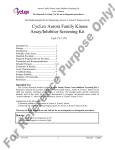
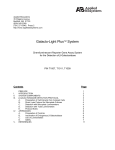
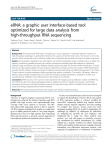
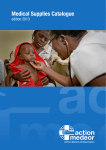
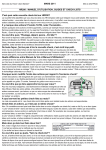
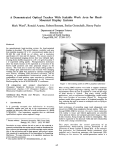
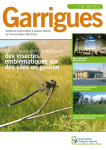
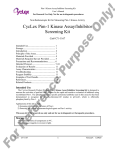

![3830 - SO02471 [96202 SW15623_0H Dwg13068A] Donovan](http://vs1.manualzilla.com/store/data/005999028_1-10b082f35c5d7c0c53e968105ce08056-150x150.png)
